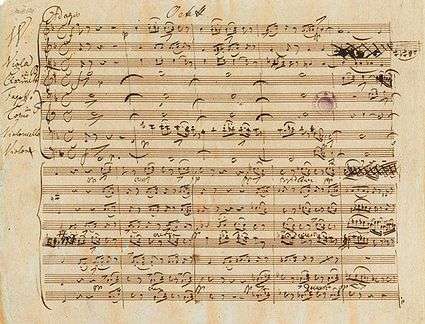Octet (Schubert)

The Octet in F major, D. 803 was composed by Franz Schubert in March 1824. It was commissioned by the renowned clarinetist Ferdinand Troyer and came from the same period as two of Schubert's other major chamber works, the 'Rosamunde' and 'Death and the Maiden' string quartets.
Structure
Consisting of six movements, the Octet takes almost an hour to perform.
- Adagio – Allegro – Più allegro
- Adagio
- Allegro vivace – Trio – Allegro vivace
- Andante – variations. Un poco più mosso – Più lento
- Menuetto. Allegretto – Trio – Menuetto – Coda
- Andante molto – Allegro – Andante molto – Allegro molto
The Octet boasts the largest scale for any chamber work by Schubert. It is scored for a clarinet, a bassoon, a horn, two violins, a viola, a cello, and a double bass. This instrumentation is similar to that of the Beethoven Septet, differing only by the addition of a second violin.
 |
Octet D. 803
1. Adagio – Allegro
2. Adagio
3. Scherzo
4. Andante
5. Menuetto
6. Andante Molto – Allegro
Performance on period instruments by:
|
| Problems playing these files? See media help. | |
Background
In response to a reported request by Troyer for a work similar to Beethoven's Septet, Op. 20, Schubert composed the Octet in early 1824. The work was first performed at the home of Troyer's employer, the Archduke Rudolf (to whom Beethoven's Archduke Trio is dedicated) and included many of the musicians who premiered the Septet.[1]
Analysis
The basic structure of the movements is similar to those of the Septet, as are many of the key relationships between the movements and principal key (E flat for the Septet, F major of the Octet).[2] The theme of the first movement is derived from Schubert’s song Der Wanderer. The fourth movement variations are based on a theme from Schubert's Singspiel Die Freunde von Salamanka.[3]
Recordings
The Melos Ensemble was founded to perform works such as the Octet for wind instruments and strings. The Octet was recorded in 1967 with Gervase de Peyer (clarinet), William Waterhouse (bassoon), Neill Sanders (horn), Emanuel Hurwitz and Ivor McMahon (violin), Cecil Aronowitz (viola), Terence Weil (cello) and Adrian Beers (double bass).[4]
A recording of the chamber ensemble of the Academy of St Martin in the Fields with Iona Brown (violin I) and Timothy Brown (horn) won a Grand Prix du Disque.[5]
The Camerata Freden recorded it in 2003 with Adrian Adlam (violin I), Cristiano Gualco (violin II), Michael Hesselink (clarinet), Marjolein Dispa (viola), Michel Dispa (cello), Ilka Emmert (double-bass), Letizia Viola (bassoon) and Ron Schaaoer (horn).[6][7]
Janine Jansen (violin I) along with Gregory Ahss (violin II), Nimrod Guez (viola), Nicolas Alstaedt (cello), Rick Stotijn (double bass), Andreas Ottensamer (clarinet), Fredrik Ekdahl (bassoon) and Radek Baborák (horn) performed, and (video) recorded, the piece at the International Chamber Music Festival 2015 in Utrecht. [8][9]
Notes
- ↑ Gibbs, p. 188
- ↑ Gibbs, pp. 188–189
- ↑ Gibbs, p. 190
- ↑ Melos Ensemble – Music among Friends EMI
- ↑ "Timothy Brown". Royal College of Music. 2011.
- ↑ Schubert: Octet In F Major / Camerata Freden , arkivmusic.com. Retrieved 21 March 2011
- ↑ Laurence Vittes, Review: Schubert: Octet, D. 803, Audiophile Audition (online magazine), March 2005. Retrieved December 21, 2008
- ↑ YouTube. Schubert: Octet in F groot, D 803 - Janine Jansen & Friends - IKFU 2015 - Live Concert HD
- ↑ Kamermuziek Festival programma
References
- Gibbs, Christopher (1997). The Cambridge Companion to Schubert. Cambridge Companions to Music. Cambridge University Press.
External links
| Wikimedia Commons has media related to Octet (Schubert). |
- Octet: Scores at the International Music Score Library Project
- Performance of the Octet on modern instruments by the Musicians from Marlboro from the Isabella Stewart Gardner Museum in MP3 format